![]()
![]()
![]()
Use LEFT and RIGHT arrow keys to navigate between flashcards;
Use UP and DOWN arrow keys to flip the card;
H to show hint;
A reads text to speech;
37 Cards in this Set
- Front
- Back
|
What is a hormone?
|
- Chemical messengers released from one tissue, carried in the circulations, and producing a specific, receptor-mediated change in another tissue
|
|
|
What are the 4 main areas that hormones are involved in?
|
1. Development = proliferation, growth, differentiation, organogenesis
2. Metabolism = energy storage, metabolic rate, temperature 3. Reproduction = sexual maturation and behaviour, pregnancy and lactation 4. Fluid homeostasis = water balance, salt levels, blood volume, pressure |
|
|
Where are main endocrine glands found, and what 5 tissues have an endocrine function?
|
Endocrine glands
1. Hypothalamus 2. Pituitary (anterior and posterior) 3. Thyroid 4. Parathyroid 5. Adrenal cortex and medulla 6. Pancreas 7. Gonads = ovary and uterus / testes Tissues with an additional endocrine function (to its primary function): 1. Kidney = erythropoietin 2. Heart = atrial natriuretic peptide 3. Gut = gastrin, secretin, motilin 4. Adipocytes = leptin 5. Placenta = lactogen |
|
|
Describe a basic endocrine system
|
1. Stimulus (+ve or -ve) acts on gland (e.g. ACRH from hypothalamus on anterior pituitary)
2. Gland releases hormone A causing a concentration change (e.g. ACTH) 3. Change in concentration (+ve or -ve) acts on target tissue (e.g. adrenal cortex) 4. If increase in concentration, target tissue may produce action or may release Hormone B (e.g. cortisol) 5. Hormone B usually negatively loops back to inhibit original gland |
|
|
Describe the 4 types of signalling of a cell via a hormone
|
1. Autocrine = Released hormone acts on the releasing cell to initiate a response e.g. insulin released by pancreatic cells
2. Paracrine = the hormone released from a cell acts on nearby cells to initiate a response e.g.stomach releases gastrin due to paracrine somatostatin release 3. Endocrine = cell releases hormone into the bloodstream, where it reaches its target cell and initiates a response 4. Neurocrine = hormone released from the axon of a neurone into the bloodstream, and reaches a target cell to initiate a response e.g. posterior pituitary receives its stimulus from the axons of the hypothalamus |
|
|
Give examples of hormones derived from amino acids and lipid precursors
|
Amino Acids:
- Single amino acid derivatives = serotonin - Dipeptides = thyroxine - Small peptides = somatostatin, AVP, TRH - Intermediate-sized particles = insulin, PTH - Complex polypeptides = gonadotrophins, TSH Lipid Precursors - Cholesterol derivatives = cortisol, testosterone, oestradiol - Fatty acid derivativces = prostagladins |
|
|
Describe the characteristics of peptides and catecholamines compared with steroids and thyroid hormones
|
1. Changes in [plasma]
- peptides and catecholamines (P&C) result in rapid changes - Steroids and thyroid hormones (S&T) result in slow fluctuations 2. Plasma half-life - P&C = short (sec to min) - S & T = long (min to days) 3. Type of receptors - P&C = cell membrane - S&T = intracellular 4. Mechanism - P&C = activate preformed enzymes. Enter via secretory granules. Constitutive and bursts. - S&T = Stimulate protein synthesis. Direct rapid passage. Related to secretion rate. 5. Speed of effect - P&C = rapid (sec to min) - S&T = slow (hrs to days) |
|
|
Describe the process of hormone synthesis in protein and peptide hormones, and steroid hormones
|

Protein and peptide hormones:
A. Gene transcription in the nucleus B. mRNA takes code to the RER for translation C. Translation on the RER D. Prohormone released from RER and transferred to golgi apparatus for post-translation processing E. Golgi packages the hormone into secretory vesicles F. Exocytosis of cell on stimulation Steroid 1. Hydrolysis of esters and release of cholesterol = regulation here 2. Cholesterol converted to pregnenolone in the mitochondrion 3. Processing of the pregnenolone to form steroids in the Smooth ER 4. Diffusion of the steroid hormones out of the cell (no regulation at this level) |
|
|
Describe the pathway of catecholamine hormone synthesis in the adrenal medulla
|
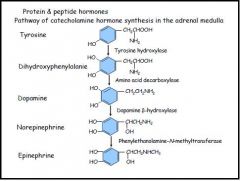
- Simple, slight changes in the reaction pathway to make the appropriate hormone
- This is greatly energy saving |
|
|
Give an example of a positive feedback mechanism
|
- Very rare in the endocrine system
- E.g. ovulation = oestrogen stimulates LH which stimulates ovaries to produce more oestrogen |
|
|
Describe the neuroendocrine axis
|
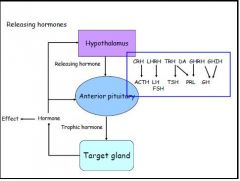
1. Hypothalamus stimulated to release 'releasing' hormones
2. Releasing hormones act on the anterior pituitary 3. Anterior pituitary releases trophic hormones 4. Trophic hormones act on target gland 5. Target gland releases its own hormones and/or produces effect 6. Effect negatively feeds back on anterior pituitary and hypothalamus |
|
|
Give an example of the neuroendocrine axis
|
- HPA-axis an example of the neuroendocrine axis
1. Stress stimulates the hypothalamus to release CRH 2. CRH acts on anterior pituitary to release ACTH 3. ACTH acts on adrenal cortex to release cortisol 4. Cortisol molecules exerts a negative feedback mechanism on the anterior pituitary and the hypothalamus |
|
|
Describe 8 functions of cortisol
|
1. Maintains muscle function, decreases muscle mass (catabolic)
2. Decreased bone function, increased bone resorption 3. Decreased connective tissue 4. Inhibit inflammatory and immune response 5. Maintain cardiac output = decrease endothelial permeability, increase arteriolar tone 6. Facilitate the maturation of the foetus 7. Increase glomerular filtration and water clearance (aldosterone also has this function and is 400x more effecting at controlling sodium, absorption, but there is 1000x more cortisol in the system) 8. Modulate emotional tone, wakefulness |
|
|
Describe hormone receptors
|
- Hormone levels in the circulation are low = in the range of pg/ml - ng/ml
- Hormone effects are mediated by specific, high affinity receptors - Receptors are present inside the cell (e.g. receptors for steroid and thyroid hormones) or on cell membrane (polypeptides and protein hormones) |
|
|
Describe the binding and actions of insulin
|
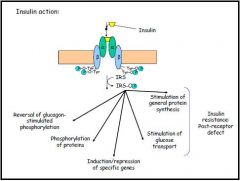
- Insulin binds to tetrometric cell-surface Y-protein, causing a conformational change by phosphorylating tyrosine residues
- Phosphorylation of tyrosine causes the phosphorylation of IRS (insulin receptor substrate) - IRS-P causes insulin actions: 1. Reversal of glucagon-stimulated phosphorylation 2. Phosphorylation of proteins 3. Induction/repression of specific genes 4. Stimulation of glucose transport 5. Stimulation of general protein synthesis - Insulin resistance = post-receptor defect |
|
|
Describe the mechanism of action of hormones of the steroid-thyroid family
|
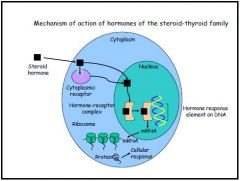
1. Steroid hormone diffuses into the cell
2. Steroid binds to its cytoplasmic receptor 3. Hormone-receptor complex migrated into the nucleus and binds to its hormone response element on DNA 4. Binding on the HRE causes stimulation of transcription down-stream 5. mRNA takes copy of code to ribosome for translation 6. Translated protein acts within the cell to produce a response |
|
|
Describe 3 endocrine disorders and how they cause various endocrine diseases
|
Endocrine disorders:
1. Excess secretion of a hormone 2. Deficient secretion of a hormone 3. Failure to respond to a hormone (usually due to absence or malfunction of a receptor) Endocrine diseases - Diabetes mellitus = insulin deficiency or insensitivity - Thyroid disease = too little or too much hormone - Infertility = hypothalamic, pituitary or gonadal deficiency - Obesity = leptin insensitivity? |
|
|
Describe the various levels of disorders that can result in hypo-function and hyper-function
|
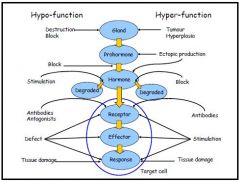
Hypofunction:
- Gland = destruction, block - Prohormone = block breakdown to hormone - Hormone = over-stimulation of degradation - Receptor = antibodies or antagonists prevent binding, defect - Effector = defect - Response = defect, tissue damage Hyper-function - Gland = tumour, hyperplasia leading to over-production - Prohormone = ectopic production (usually tumour) - Hormone = ectopic production, block in the degradation (lengthens half-life) - Receptor = antibodies cause over-binding, over-stimulation - Effector = over-stimulation - Response = over-stimulation, tissue damage |
|
|
Describe clinical conditions associated with pituitary hormone disorders
|
TSH
- Deficiency = hypothyroidism - Excess = thyrotoxicosis ACTH - Deficiency = hypoadrenalism - Excess = Cushing's disease FSH/LH - Deficiency = Hypogonadism - Excess = Precocious puberty GH - Deficiency = short stature - Excess = gigantism, acromegaly Prolactin - Deficiency = none - Excess = galactorrhoea (abnormal milk secretion from the breasts)/infertility |
|
|
Describe the major endocrine organs and their major problems when endocrine function is impaired
|
1. Thyroid
- Hyper/hypo-thyroidism - Goitre - Carcinoma thyroid 2. Pancreas - Diabetes 3. Kidney - Renin-dependent hypertension 4. Testes - Sub-fertility 5. Bone - Osteoporosis - Osteomalacia 6. Pituitary and hypothalamus - Hyperprolactinaemia - Hypopituitarism - Pituitary tumours 7. Parathyroid glands - Hyperparathyroidism 8. Breast - Hyperprolactinaemia 9. Adrenals - Addison's disease - Cushing's syndrome - Conn's syndrome 10. Ovaries - PCOS (polycystic ovarian syndrome) - Menopause - Sub-fertility |
|
|
Describe common presenting complaints of endocrine disease
|
1. Body size/shape
- Short stature - Tall stature - Excessive weight gain/loss - Excessive weight 2. Metabolic effects - Tiredness/weakness - Altered appetite - Polydipsia - Polyuria - Tremor - Anxiety 3. Skin - Hair thinning - Pigmentation - Dry skin - Excess sweating 4. Reproduction/sex - Loss/absence of libido - Impotence - Amenorrhoea/oligomenorrhoea - Sub-fertility - Galactorrhoea - Delayed puberty - Precocious puberty 5. Local effects - Swelling in the neck - Bone or muscle pain - Protrusion of the eyes - Visual loss - Headache |
|
|
Describe the hormones released from the posterior pituitary and their actions
|
- Posterior pituitary releases oxytocin and vasopressin on stimulation of the hypothalamus
- Oxytocin stimulated when pregnant woman approaches term = acts on the mammary glands for milk ejection, and the uterus to stimulate contractions - Vasopressin acts on the kidney to increase water resorption = increases blood volume and decreases [Na+] concentration |
|
|
Describe the release and effects of growth hormone in the body
|
- GH is not produced continually = goes through phases of secretion and quiescence
- Positive stimulation of the hypothalamus causes it to release GHRH - GHRH acts on the anterior pituitary, causing it to release growth hormone - The presence of growth hormone causes negative feedback on the hypothalamus, stimulating it to release somatostatin, which inhibits the release of growth hormone Growth hormone actions: - Stimulation of growth, increased body protein content and decreased body fat content - Muscle = increases protein synthesis, decreased glucose uptake. Anti-insulin effect - Adipose = increase lipolysis - Liver = increased gluconeogenesis, increased glycogen synthesis - Various tissues = stimulates local production of insulin-like growth factors IGF-1 and IGF-II which produce most of its effects on growth and metabolism - In excess GH is diabetogenic |
|
|
What are the causes and symptoms of acromegaly
|
- Acromegaly caused by growth hormone hypoer-secretion
- Usually caused by a pituitary tumour - Produced gigantism in children = before epiphyseal fusion - Symptoms Change in appearance Increased size of hands/feet Headaches Visual deterioration Tiredness Weight gain Amenorrhoea Galactorrhoea Impotence or poor libido Deep voice Goitre Excessive sweating Polyuria/polydipsia Joint pains |
|
|
Describe the release of thyroid hormones
|
- Neurotransmitters stimulate the hypothalamus to release thyroid releasing hormone TRH
- TRH acts on the anterior pituitary to stimulate the release of thyroid stimulating hormone TSH - TSH acts on the thyroid to release T3 and T4 - T3 and T4 cause an increase in protein synthesis and BMR - The presence of T3 and T4 negatively feeds back to the anterior pituitary and the hypothalamus, inhibiting further secretion |
|
|
Describe the mechanism of action of thyroid hormones on target cells
|

- Thyroxin-binding globulins (TBG) are carrier proteins that take the hormone to its target organ and prevent it being broken down in the blood
- Some thyroxine is released from the carrier protein and allowed to diffuse into the cell - Diffuse thyroxine binds to intracellular binding proteins and then enters the nucleus - Thyroxine-protein complex binds to receptor protein (HRE) on DNA, causing up-regulation of transcription - On DNA, T3 is preferentially bound over T4 by 90% - For T3 to work the presence of retinoic acid is also necessary - The binding of retinoic acid to its receptor, and T3 to its receptor causes dimerization of the receptors, allowing them to bind to the hormone response element on the DNA - Produced mRNA leaves the nucleus and results in protein synthesis of thyroid hormone response elements (TRE) - TREs include: Na-K pump Gluconeogenic enzymes Respiratory enzymes Myosin heavy chain Beta-adrenergic receptors |
|
|
Give the common symptoms and causes of hyperthyroidism
|
Symptoms
- Weight loss - Increased appetite - Irritability/behavioural changes - Restlessness - Muscle weakness - Vomiting - Diarrhoea - Eye complaints - Goitre - Loss of libido - Tall stature (in children) Common causes - 5 times more common in females - Grave's disease (autoimmune) - Toxic multi-nodular goitre - Exogenous iodine (iodine necessary for the synthesis of thyroxine) - Pituitary tumours (TSH secreting tumours) |
|
|
Give the common symptoms and causes of hypothyroidism
|
Symptoms:
- More common in females - Tiredness - Weight gain - Anorexia - Poor memory - Changes in appearance - Depression - Deafness - Psychosis - Poor libido - Goitre (no T4 so no negative feedback so continual stimulation) - Constipation Causes - Congenital: Agenesis Ectopic thyroid remnants Defects in hormone synthesis Iodine deficiency - Antithyroid drugs Lithium - Autoimmune Hashimoto's thyroiitis - Infiltration Tumour - Post-surgery Post-irradiation |
|
|
Describe the secretion of cortisol and its major effects
|
1. Hypothalamus positively stimulated to release corticotrophin-releasing hormone (CRH)
2. CRH acts on anterior pituitary to stimulate POMC (pro-opimelanocortin) to be made into adrenocorticotrophin hormone (ACTH) 3. ACTH acts on the adrenal cortex to release cortisol 4. Cortisol negatively feedbacks on the anterior pituitary and the hypothalamus Effects of cortisol: - Anti-inflammatory and immune suppression - Muscle = increases protein breakdown - Adipose = increases lipolysis - Liver = increases gluconeogenesis, increases glycogen synthesis |
|
|
Describe the symptoms and causes of Cushing's syndrome
|
- Cushing's syndrome = glucocorticoid excess
Symptoms - Selective accumulation of abdominal fat and a loss of musculature in the extremities - Thin skin reveals blood flow through underlying vessels - Central weight loss - Depression - Change in appearance - Psychosis - Insomnia - Amenorrhoea - Poor libido - Thin skin - Bruising - Growth arrest - Back pain - Polyuria/polydipsia |
|
|
Describe the symptoms and causes of Addison's disease
|
- Hypoadrenalism = lack of cortisol
Symptoms - Weight loss - Anorexia - Weakness - Fever - Depression - Impotence/amenorrhoea - Nausea/vomiting - Diarrhoea/constipation - Confusion - Abdominal pain - Back pain Causes - Destruction of adrenal cortex - Reduced glucocorticoid, mineralocorticoid and sex steroid destruction - Autoimmune disease (90% UK) - Tuberculosis (10% UK) - Others |
|
|
Describe the secretion and actions of follicle stimulating hormone (FSH) and Luteinizing hormone (LH)
|
1. Hypothalamus receives positive stimulation from neurotransmitters and releases gonadotrophin releasing hormone (GnRH)
2. GnRH stimulates the anterior pituitary to release FSH and LH 3. LH stimulates the production of testosterone, or oestrogen and progesterone via the testes or ovaries 4. Testosterone, oestrogen and progesterone negatively feedback on the anterior pituitary and the hypothalamus 5. Inhibited hypothalamus secretes gonadotrophin releasing inhibitory hormone (GnRIH) which acts on the pituitary to further inhibit the release of FSH and LH FSH actions: - Testes = stimulates sertoli cells to release androgen binding protein, aiding in the production of sperm - Ovaries = stimulates follicle development, to release oestrogens LH actions: - Testes = stimulates Leydig cells to release testostrone, aiding in the maturation of sperm - Ovaries = stimulates ovulation, and the corpus luteum to release progesterone and oestrogen |
|
|
Describe the effects of androgens and the consequences of deficiencies in males
|
General:
- Maintenance of libido - Deepening of voice - Facial, axillary and limb hair - Maintenance of erection and ejactulatory function Pubic hair: - Maintenance of male pattern Testes and scrotum: - Maintenance of testicular size/consistency - Stimulation of spermatogenesis Musculoskeletal - Maintenance of muscle bulk - Maintenance of bone mass Consequences of deficiency: - Loss of libido - High-pitched voice - Decreased hair - Loss of erection/ejaculation - Thinning and loss of hair - Small soft testes - Sub-fertility - Decreased muscle bulk and power - Osteoporosis |
|
|
Describe the effects of Oestrogens and consequences of deficiencies in females
|
Breast:
- Development of connective and duct tissue - Nipple enlargement and areolar pigmentation Pubic hair - Maintenance of female pattern Vulva and vagina: - Vulval growth - Vaginal glandular/epithelial proliferation - Vaginal lubrication Uterus and tubes: - Myometrial and tubal hypertrophy - Endometrial proliferation Skeletal - Maintenance of bone mass Consequences of deficiencies - Small, atrophic breasts - Thinning and loss of hair - Atrophic vulva - Atrophic vagina - Dry vagina and dyspareunia |
|
|
Describe the secretion and effects of prolactin (PRL)
|
- Positive stimulation from neurotransmitters on the hypothalamus causes release of prolactin releasing hormone (PRH)
- PRH acts on the anterior pituitary to release prolactin (PRL) - Prolactin negatively feeds back to the hypothamus - Negative feedback causes the hypothalamus to release dopamine, which inhibits PRL release at the anterior pituitary - Prolactin acts on the mammary gland to synthesise milk proteins |
|
|
List the hormones released from the major endocrine organs
|
Hypothalamus:
- Releasing hormones: GHRH, TRH, GnRH - Inhibitory hormones: somatostatin, dopamine Anterior pituitary: - GH - Prolactin - FSH - LH - TSH - ACTH Posterior pituitary - Oxytocin - ADH Thyroid: - Thyroid hormones (T3 and T4) - Calcitonin Parathyroid - Parathyroid hormone Adrenal cortex: - Cortisol - Aldosterone - Adrenal androgens Adrenal medulla - Adrenaline - Noradrenaline Pancreas - Insulin - Glucagon - Somatostatin Gonads: - Oestrogens - Progesterone - Testosterone Heart - atrial natriuretic peptide (ANP) Kidney - Erythropoietin Gut - Gastrin - Secretin Adipocytes - Leptin Placenta - Lactogen |
|
|
List 4 different methods of detecting hormone levels
|
1. Radioimmunoassay (RIA)
- Uses a highly specific radioactive antibody against a hormone - Measures the amount of Ab-hormone complex in the solution using the radioactive decay of the Ab - High radioactivity suggests small amounts of natural hormone and vice-versa 2. Enzyme-linked immunosorbant assays (ELISA) 3. Gas chromatography linked to mass spectometry (GC/MS) 4. Bioassays - Measure of physiological response induced by the sample |

